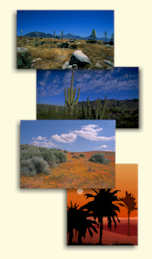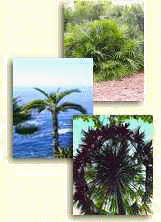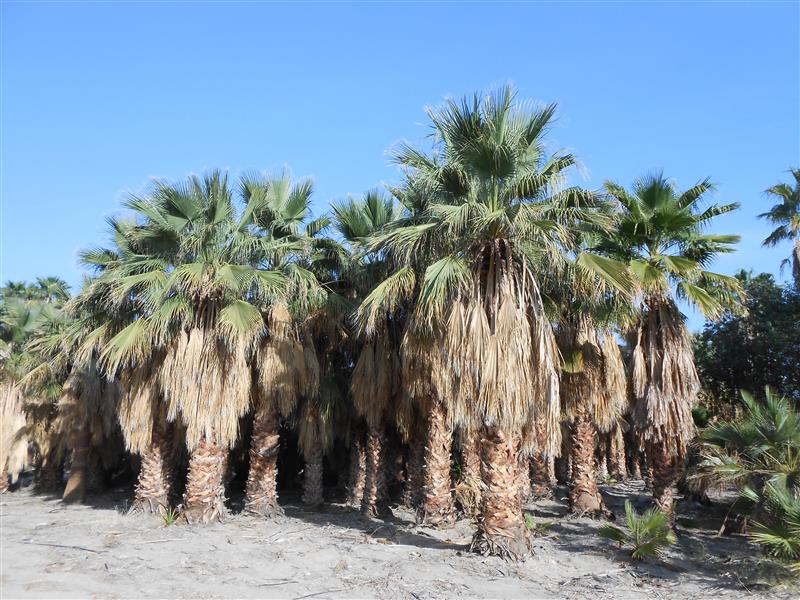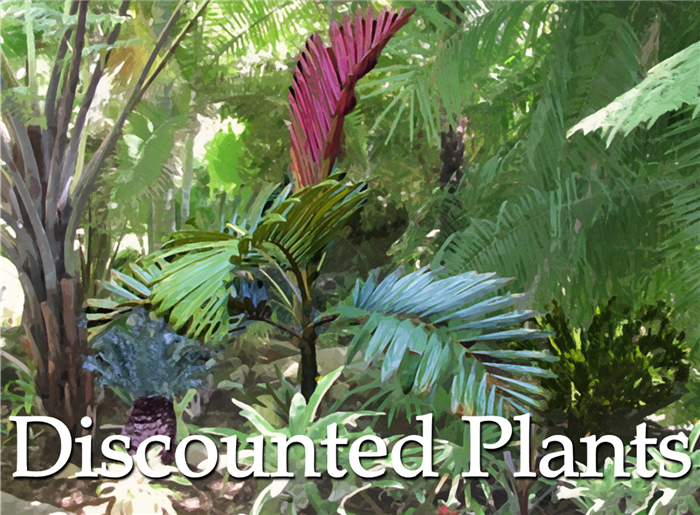| Botanical Name | Common Name | Comments | Approx. Cold Tolerance | Photo |
| Acoelorrhaphe wrightii | Silver Saw Palmetto, Paurotis Palm, Everglades Palm | A profusely suckering, thin-trunked, medium sized fan palm that is native to the Everglades area and likes wet conditions. It will tolerate high moisture conditions and temperatures to about 20 F. It prefers full sun. In desert areas, one must insure adequate water. Heights in the tropics can reach up to thirty or more feet. One might think it looks like a Chamaerhops, but the trunks are thinner and the overall appearance is more tropical. | 20 F |  |
| Acrocomia species | | I’ve received reports of this genus growing in Arizona and find it quite amazing. These are spiny, single trunk palms of good height and caliper. Id say be cautious with this genus until we get more data, and only consider it if you do not experience bitter cold. | mid-20’s F. ? |  |
(not recommended)
Archontophoenix species | King Palm | This genus is mentioned so people don’t get led astray. There is no question that King palms are growing in Phoenix, Arizona. But, as best as I can ascertain, they are all growing in protected areas. I would not recommend this species for full sun. Filtered light is possible if you don’t get much below 28 F. I think colder desert areas should not try this genus and no one should grow it in full sun in the desert. | 25-27 F |  |
| Allagoptera arenaria | Beach Palm, Sand Palm | This is a small palm from Brazil. It grows near the ocean. But, it seems to tolerate inland heat and sun in many areas. A miniature, never much taller than about 6 feet, is fairly slow growing and suckers. It is pinnate and hard to find. It will tolerate down to about 28 F. | 28 F |  |
| Bismarckia nobilis | Bismark palm, Bismarck palm | As time passes, we are finding that this magnificent blue fan palm, Bismarckia, is growing in multiple desert areas, and it is rapidly becoming a very sought after desert palm tree. It loves the full hot sun. But, its cold tolerance is limited, only tolerating at best the mid-twenties F. This species is being grown in some areas of Arizona. It is medium sized with an impressive display of flat, blue leaves. Bismarckias do not dig or transplant well. | Mid 20’s F |  |
| Butia capitata | Jelly Palm, Pindo Palm, Wine Palm | A pinnate, single-trunk palm of medium stature with gray-green leaves that re-curve downwards and tolerates temperatures into the mid-teens F. Commonly known as the Pindo Palm or the Jelly palm. This species is a great Desert Palm Tree. | Mid teens F |  |
| Butia eriospatha | Woolly Butia Palm | Similar to Butia capitata, but only tolerates to about 20 F. It is distinguished by wooly material on the heart and flowers. It has a medium height and tolerates full, hot sun. | 20 F |  |
| Brahea aculeata | Sinaloa Hesper Palm, Sinaloa Hesper Palm | A single trunk, medium sized fan palm with blue-green leaves that is somewhat slow growing and tolerates temperatures to approximately 18 to 20 F. It tolerates full sun and never gets too tall. Its growth rate is slow to medium. | 18 to 20 F |  |
| Brahea armata | Mexican Blue Fan Palm, Blue Hesper palm | A single trunked, silver-blue palm with fan leaves and somewhat slow growth. It has a thick trunk, medium height and impressive long, yellow blossoms. Known as the Mexican Blue Palm, this species tolerates temperatures into the mid-teens and loves full sun and lots of heat. | 16
F |  |
| Brahea edulis | Guadalupe Palm, Assai Palm | A slow growing, medium sized fan palm with a rather stout trunk and green leaves. Known as the Guadalupe Fan Palm, this species tolerates full sun and wind. At maturity it can reach 25 to 30 feet. It tolerates down to about 18 to 20 F. 12 to 15 F. will definitely damage the foliage of this species. Its growth rate is slow. | 18 to 20 F |  |
| Brahea nitida | | Another Brahea species that tolerates sun and temperatures into the upper teens. It has no armor on the petioles and has large, somewhat flattened green leaves. Its mature height is small to medium. It also can tolerate less than full sun inland. | |  |
| Brahea species,other | | Almost all Brahea species are worth a try. But, some such as B. dulcis or moorei would require less than full sun. Brahea decumbens is a miniature, suckering species of this genus and sports a very blue color. Brahea clara, elegans and brandegii all tolerate full sun and a fair amount of cold. All are different in form and appearance. | |  |
| Chamaerops humilis | European Fan Palm, Mediterranean Fan Palm | A suckering fan palm with medium height, somewhat small leaves and minor petiole armor, this species is slow growing but can eventually obtain heights of over 25 feet on its tallest trunks. Green in color and known as the Mediterranean Fan Palm, this species tolerates cold down to about 10 F. | 10 F |  |
| Chamaerhops humilus var. cerifera | Blue Mediterranean Fan palm | Actually a variety of C. humilus, this plant is extremely blue in full hot sun and tolerates desert conditions perfectly. Native to Morocco, this palm is thick, blue and a bit bushy. Fairly recent to cultivation, the C. cerifera offers the grower a different color than the typical green with most species. | prob. low teens F. |  |
| Coccothrinax species | | All Coccothrinax are relatively small, single trunk fan palms that like sun. None get much over 15 to 20 feet. Some have thatched or hairy trunks. All are cute and somewhat petite. There are reports of some Coccothrinax living in desert areas. But, cold must be a consideration as no species tolerates less than 25 F. | 25 F |  |
| Copernicia species | | This is an amazing group of fan palms. Some sucker, but most are single trunk. All have fan leaves, some quite large and held stiff, in an erect position. Some have massively fat trunks. | |  |
| Copernicia baileyana | Cuban
Paddle
Palm, The Yarey Palm | Copernicia glabrescens, a suckering species, is said to tolerate down to 20 F. But, all love the heat and sun. Therefore, they are worth a try but are near impossible to find for sale. | 20 F | |
| Copernicia glabrescens | | Dypsis decipiens A fairly new introduction to the palm market, this is a gorgeous palm that is single or multiple trunked, crown shafted, pinnate and tolerates down to about 20 F. Native to Madagascar, this species is slow growing but worth the wait. Size is up to 30 feet, although this would take many years. It likes full sun and may be a good species for inland hotter areas, although conclusive data is pending. I’d probably recommend starting this species in part day sun only. The nice thing about this species is that it might be one of the only crown shafted palms available for the inland grower. But, be cautious as we are not sure of long term survival. | 20 F |  |
| Dypsis decipiens | Manambe palm | Dypsis decaryi This striking single trunk palm is pinnate with a most unusual modified crown shaft. It is triangular, hence the name Triangle Palm. It is from Madagascar and a medium sized palm that tolerates perhaps down to 26 F. It has grayish-green leaves and a round, medium sized trunk. Its crown base is its hallmark. It loves sun and heat, but some growers say it would do better in part day sun rather than full sun. | 26 F |  |
| Dypsis decaryi | Triangle Palm | This unique genus of palms are known as the branching palms. They can bifurcate (divide in two) above the ground in a tree like pattern. All are fan palms. All love heat and sun. But, they typically don’t take temperatures below the mid-twenties. Leaf colors range from green to blue. Some get quite large. All love the heat and sun, but none like really cold nights. A cold and damp winter is this genus enemy. | 26 F |  |
| Jubaea chilensis | Chilean Wine Palm, Coquito Palm | A very thick-trunked, tall pinnate palm known as the Chilean Wine Palm. It is very slow growing, can tolerate inland sun and a good deal of cold, probably to about 15 F. There are specimens in hot inland areas, but the ultimate desert tolerance of this species is still not clear. Large specimens are quite expensive. There are reports of some successes in hot desert areas, but a full recommendation for this genus is not yet possible. | 15 F |  |
| Jubaeopsis caffra | Kaffir Palm, Pondoland Palm | This is a suckering, medium sized, pinnate palm that is expensive and hard to find. It looks like a suckering Coconut Palm. It prefers full sun and is wind tolerant. Tolerates temperatures to about 22 F. Its use in the desert areas is limited, so no conclusive information is available as of yet. | 22 F |  |
| Livistona australis | Australian Fan palm, Australian Cabbage Palm, Australian Cabbage Tree Palm | This species is a medium height, thin-trunk, fan palm with good sun tolerance and cold tolerance to about 20 F. It is fast growing for a fan palm and very attractive. As with many Livistona, this species seems to tolerate inland sun. | 20 F |  |
| Livistona chinensis | Chinese Fan Palm | A slower growing, thick trunk, fan palm with rather large, flat green leaves that tolerates temperatures down to approximately 20F. In the desert, it would probably do better with half day sun. | 20F |  |
Livistona decipiens
aka Livistona decora | Ribbon Fan Palm, Weeping Cabbage Palm | A fast growing Livistona species that takes about 18 F. It has wispy-drooping leaflets, and gets very tall, it has a somewhat thin trunk, and is fast growing for a fan. It prefers full sun, even inland. This is a very attractive and under-appreciated palm tree. | 18 F |  |
Livistona species,
other | | Livistona species, other There are many other species of Livistona. Most tolerate full sun and have potential for desert areas. Most tolerate some cold. All are fan palms with relatively thin trunks for their height. All have small armor on their petioles. | |  |
| Nannorrhops ritcheana | Blue Mazari palm, Mazari Palm | A suckering, small (to 12 feet) attractive fan palm that has green and blue forms. This clumping palm tolerates hot sun, dry conditions, and temperatures to about 15 F or slightly lower. | 15 F |  |
| Phoenix canariensis | Canary Island Date Palm, Canary Palm, Pineapple Palm | Known as the Canary Island Date Palm, this stately palm has a thick trunk and eventually heights to almost fifty feet. It has pinnate leaves and long spines near the base of the petiole. It is slow growing and wants full sun. Large specimens are typically moved from location to location, especially in upscale developments. It tolerates temperatures into the mid teens F. Recent pruning practices at the top of the trunk have led this species to be called the Pineapple Palm. | 15 F |  |
| Phoenix dactylifera | Edible Date Palm, True Date Palm | This, the true Date palm, has been used commercially in the desert areas of Palm Springs for years. It takes a female to give dates. Naturally, this plant suckers. Most remove the suckers. It loves heat and desert sun. When pruned and cleaned up, produces the knobby-like trunk which is seen in commercial plantings. | 18 F |  |
| Phoenix reclinata | African Wild Date Palm, Senegal Date Palm | This is a suckering, pinnate palm of medium stature that, with time, produces a real stately, impressive specimen. It needs room and tolerates dry inland heat and sun. Its cold tolerance is to about 20 F. Native to South Africa, this species has been used commercial so much that it has hybridized with other Phoenix. True, this species have flat leaves. Hybrids tend to be more plumose. | 20 F |  |
| Phoenix roebelenii | Pygmy Date Palm, Dwarf Date Palm | The Pigmy Date Palm is single trunk, but often planted as multiples together. They are petite, hardly every above 15 feet when mature. They like full sun and heat but don’t tolerate temperatures below 25 F. | 25 F |  |
| Phoenix rupicola | Cliff Date Palm | This is a medium sized, single trunk palm known as the Cliff Date Palm. It has soft, vibrant green leaves that are flat. It is a gorgeous palm to grow. But, it only tolerates temperatures to about 25 F. It may be worth trying in your warmer desert area. | 25 F |  |
| Phoenix sylvestris | Silver Date Palm, Sugar Date Palm | Native to the Himalayas and nearby mountain ranges, this single trunked, large, silver-green pinnate palm prefers full, hot sun and will take temperatures down to about 22 F. It is very armed and needs room. Smaller than the Canary Island Palm, it is still quite impressive. But, its blue color really shows in hot, dry climate. It would be considered a medium to large tree. | 22 F |  |
| Phoenix theophrastii | Cretan Date Palm | A suckering, heavily armed and sharply pointed suckering pinnate palm that tolerates more cold than P. reclinata and gets a bit taller. It will take down to about 16 to 18 F, likes hot sun, and has a bit of blue color to the leaves. | 16 to 18 F |  |
| Psuedophoenix species | | There are some early reports that species of this genus are surviving in hot, desert areas. More data is needed. All are single trunk, crown shafted and beautiful. We will keep you posted with updates as more data comes in. | uncertain perhaps mid twenties F. |  |
| Ravenea glauca | | This is a fairly new species to nurseries. It is medium sized, up to about 20 feet. The surprising thing is the success its had in some inland areas. Although we don’t really know yet how far inland this species will grow, it may prove to be a surprise. It is pinnate, single trunk and very beautiful. It tolerates down to about 27 F. If you do try it, put it in part day sun at most. | 27 F. |  |
| Ravenea xerophylla | | This unbelievably slow growing, blue pinnate leafed palm is from Madagascar and seems to thrive in full, hot sun. So far, it seems to tolerate mid to upper twenties F. Reports are that some plants are growing in Arizona. Time will tell, but this species may prove to be a desert winner. | 25 + F | %20(Custom).JPG) |
| Rhapidophyllum hystrix | Needle Palm, Porcupine Palm, Hedgehog Palm, Blue Palmetto | Probably this species is the most cold hardy of all palms. It is a small to medium sized, suckering fan palm that will grow in sun or filtered light. It will tolerate under 0 degrees F. It never gets over ten to 12 feet and suckers. It would probably look its best in less than full sun. Morning sun might prove to be perfect for this species, known as the Needle Palm. It has a hairy trunk with long needle-like spines. | 0 F |  |
| Roystonea regia | Cuban Royal Palm | (and other species) Although only cold tolerant down to about 26 to 28 F, there are some desert areas that can grow this beauty. So, be cautious if you see sever cold weather. It seems to tolerate the desert sun and heat and is very quick growing. There are many reports of this species growing in Phoenix, AZ. | 26 to 28 F |  |
| Sabal mauritiformis | Savannah Palm | Sabal mauritiformis is an exception and doesn’t take much cold. Many will take into the mid teens F. but not this species. Other Sabals worth considering include S. etonea, minor, palmetto,mexicana, yappa, rosei bermudana, blackburniana and causarium. | 15 F |  |
| Sabal minor | Dwarf Palmetto, Bush Palmetto, Swamp palmetto | This is a small, minimally-trunking (if at all) fan palm that is native to the Southwest United States. It tolerates full sun and cold to about 15 F. Its a good choice where a small palm is needed. | 15 F |  |
| Sabal riverside | The Riverside Palm | A blue-green, large fan palm that tolerates hot sun and is quick growing. It is probably a form of a Caribbean Sabal that just happens to take cold quite well. It tolerates full, hot inland sun. Recent reports are this species does well at 12 F. | 12 F | .jpg) |
| Sabal species, other | | There are many other species of Sabals that tolerate desert conditions and thrive with the heat. Most have good cold tolerance. | |  |
| Sabal uresana | Savannah palmetto, Palma Blanca, Sonora Palmetto, The Blue Sabal | Native to Northern Mexico and Southern SE United States, this species is quite blue in color and memorable. It is medium sized, single trunked, and very beautiful. Even small seedlings are blue in the shade. It tolerates temperatures into the low 20 F. | Low 20s F |  |
| Serenoa repens | Saw palmetto | This is a small, suckering dwarf fan palm that is usually green, but sometimes a blue color. It never gets real tall, perhaps up to 8 feet. It is quite cold hardy to the low teens or a bit lower. It is slow growing and its sometimes difficult to find a big specimen. | Low 15s F |  |
| Syagrus coronata | Licury palm | This palm has an unusual trunk with retained old leaf bases that swirl up the trunk. With somewhat blue leaves, this single trunk species likes hot sun and will tolerate temperatures at best into the mid-twenties. Early reports are that it takes some inland sun. Perhaps this might prove best for part day sun in warmer desert areas. | Mid 20s F |  |
| Syagrus romanzoffiana | Queen palm | The Queen palm can tolerate to about 18 to 20 F and is solitaire, tall, and has a medium sized trunk. It can get up to 60 feet. The leaves are pinnate and plumose (fluffy). 16-17
F or colder will kill this species. It demands full sun and is being grown more and more in inland desert areas. It is fast growing and readily available. | 20 F |  |
| Thrinax species | | These medium sized fan palms are all single trunk and have rather flat, green leaves. They typically tolerate only 28 F. but can take inland sun. We need further feedback on this genus in the desert areas. | 28 F |  |
| Trachycarpus fortunei | Chinese Fan Palm, Chinese Windmill Palm, Chusan Palm, Windmill Palm | A single trunk, medium height fan palm with a hairy trunk and nice full head. Known as the Chinese Windmill Palm, it will tolerate temperatures down to about 5 F and is probably the second most cold hardy of all palms. Even though this species does tolerate some inland sun and heat, it performs better in less than full sun, especially in the hotter areas. | 5 F |  |
| Trachycarpus takil | Takil Palm | Similar to the standard Windmill Palm, this species is a fairly new introduction into the market and has split, fan leaves and cold tolerance to about 15 F. It should tolerate near or full sun in some areas, but in the hottest desert areas should be reserved for part day sun. It is a medium to small species, never getting much over 20 feet. | 15 F | %20(480x360).jpg) |
| Trachycarpus wagnerianus | | A rather small to medium sized palm with small, stiff leaves that prefers full sun along the Coast and is cold tolerant to at least 20 F. It has a hairy trunk and stiffer, smaller leaves than other species of this genus. It is very cute. Plants that are one to two decades old may only be ten or twelve feet tall. Regarding desert planting, this species is probably better than the previous two Trachycaprus. But, play it safe, probably give it less than full day sun. | 20 F |  |
| Trithrinax acanthicoma, aka Trithrinax brasiliensis | Spiny Fiber Palm | A medium sized, single trunk fan palm to about 15 feet with attractive spines on the fibrous trunk. It tolerates full sun and takes temperatures to at least 15F and perhaps 12 F. Its overall height is never much above 15 feet and it produces interesting, large slightly yellow fruits. | 15 F ( perhaps 12 F) |  |
| Trithrinax campestris | Caranday Palm | Native to South America, this species suckers, is blue in color and never gets too tall. Its leaves are pointed and very sharp. It is always hard to find and almost never available as a large specimen. It loves the desert environment and full sun. | |  |
| Washingtonia filifera | California Fan palm, Petticoat Palm, American Cotton Palm, California Palm, Desert Fan Palm | A large single-trunked, tall fan palm that loves the hot desert areas and tolerates temperatures to about 15 F or slightly colder. Not a good choice for the Coastal area, this species thrives in the desert. It is native to lower areas of Southern California and Northern Mexico. With age, its petticoat will fall off giving it a smooth woody trunk, much more stout than its sister, the W. robusta. | 15 F |  |
| Washingtonia robusta | Mexican fan palm, Washington Palm, Skyduster Palm | A rather thin but very tall fan palm known for its speed of growth and tall trunks. Common in Southern California, the Mexican Fan Palm can be seen almost everywhere. It tolerates temperatures into the upper teens F. and is commonly seen in shopping centers, golf courses, etc. When younger, its petticoat of old leaf bases must be pruned manually for maximum beauty. | Upper 15s F |  |
| Wodyetia bifurcata | Foxtail palm | This gorgeous, crown shafted, single trunk palm gets about 25 feet tall and has a fairly thin trunk. Seeds are large and bright red. It loves sun in all Coastal areas and is being grown in some inland areas. There are reports of the Foxtail Palm tolerating as low as 23 F. In time, it may prove possible for some desert areas. But, for now, give in part day sun, until its fate is more firmly understood in the hottest areas. | 23 F |  |




















%20(Custom).JPG)

.jpg)



%20(480x360).jpg)













